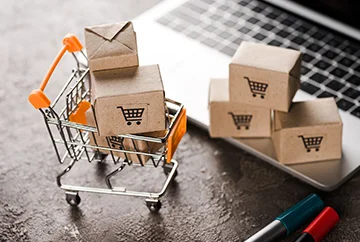Not surprisingly, Amazon was the biggest gainer, with sales growing a whopping 38% in 2020 over the previous year
eCommerce was always on the upswing, but the pandemic has accelerated the shift. The pandemic drove fundamental shifts in consumer behavior, and many of these changes are likely to be irreversible. For instance, ATM withdrawals are shrinking while digital payments are shooting through the roof.
In Europe, differences in shopping behavior across age groups and geographies have reduced substantially as many consumers (particularly older shoppers) turned to online shopping for the first time. In the US and many other places, online grocery sales-where offline had an edge-saw massive growth and are now projected to make up 20 percent of all grocery sales by 2025.
Changing habits aren't just related to purchasing only—online research is a big part of pre-purchase behavior: Sixty-two percent of the people read online reviews before making a purchase, while 47 percent visit the company's website. Eighty-two percent of smartphone users check the items on their phones before making a purchase in-store, according to a BazaarVoice report titled Robo Economy [Research Online Buy Offline]. Online presence is now mandatory, not only for large corporations but even small enterprises.
Consequently, more and more brick-and-mortar retailers are offering online shopping as well. Yet the seamless integration required for a frictionless omnichannel experience is rare; only 7 percent of the retailers can provide it, according to BRP Consulting, a retail management consulting firm, report.
How Digital Transformation Will Impact The Future Of eCommerce
The growth in eCommerce will continue: the global eCommerce opportunity is likely to multiply three-fold from around $9 trillion in 2019 to $27 trillion by 2027.
The prize is significant, and the winners will be the ones who can meet the changing needs of the customer. Over the last decade, we have seen businesses and people interact in newer ways. These have led to new habits and preferences that, in short, translate into greater expectations by consumers from the sellers.
Meeting these expectations would require a complete [digital] transformation of business processes and mindsets.
But what exactly are these expectations?
For one, they want companies to enable purchases any time and everywhere. Many customers-in fact, 71 percent—shop while they are doing something else! That is a massive opportunity-if you can sell anywhere, anytime.
While some habits are being shaped by the ever-handy mobile phones, others are emerging as a response to the Covid-19 pandemic; Contactless and same-day delivery and curbside pickups.
Rising expectations include free shipping, flexible payments, curated recommendations, subscription models, and more – all personalized and available on their terms.
Can traditional selling models address these needs?
The answer is NO.
Digitally transformed eCommerce will be omnichannel with flexible pickups and delivery options combined with multiple payment modes. For B2B players, it will mean instant quotes and integrated financing solutions for high-value items.
But smooth and seamless transactions are only one side of the story.
Customers also want engagement that includes everything from curated recommendations to reviews to product demos [in augmented reality]. A well-executed, digitally transformed multi-platform customer engagement strategy will provide a treasure-trove of data that can be leveraged to deliver greater personalization and drive higher conversion rates.
In short, a digitally transformed eCommerce landscape of the future would be ubiquitous, seamless, personalized, and informative from the customer's point of view. From the organization's perspective, it will generate rich insights into customer behavior and enable the development of new products—and in the case of B2B customers, newer models such as rentals instead of outright purchase—and higher conversion and retention rates.
Building your eCommerce Digitalization Strategy
Getting ready for the future does not mean you have to write off all your technology investments and start from scratch. Digital transformation is as much about operating models and processes as it is about technologies.
'How' is more important than 'what's in this context. Since the primary purpose of digital transformation is responding to changes, focusing on 'how' you will drive change is more important than 'what' you will change. 'Whats' will emerge organically across functions if you can reshape the organization to pursue the transformative vision with related engagement, governance, and KPIs.
An excellent place to start is to look at the 'as is' eCommerce landscape in your industry. What are your competitors doing? Where do the opportunities to best them lie?
Three Core Areas of Digital Transformation in eCommerce
As you do that, it might help to map and strategize around three key areas: reimagining customer experience, operational processes, and business model
Customer Experience
Reimagining customer experience entails a better understanding of the customer using analytics and social listening. Augment this with digital selling, predictive digital marketing, and seamless customer processes—around buying, researching, service requests, etc.—across channels.
Going multichannel is not just about offering other purchases or engagement points to buyers. You need to provide the same level of personalization to the customer when she walks into your store as you do when she is online.
For example, she can check her past orders online but can she do that in the store? Or can she search the store's inventory the same way she can search products on the website or app? In short, the experience across channels needs standardization.
Operating Processes
That brings into play the second essential part of the digital transformation of eCommerce: operating processes. A simple example of a necessary process tweak is the need to digitize all data generated within 'physical stores' and then integrate it with online information.

Digital Transformation in eCommerce
Business Models
The third bit is the business model: traditionally, B2C [Business-to-Consumer] and B2B [Business-to-Business] dominated the eCommerce discourse. However, that is changing now. Many brands are going D2C [Direct-to-Consumer] while others are shunning 'one-off sales' in favor of subscriptions.
What models suit you best would be a combination of the industry you operate in and your capabilities. For instance, if you are selling diapers, a subscription model with the right incentives might work best.
For B2B ecommerce players, they have to decide if they would focus only on lead generation for their partners or build an end-to-end platform that enables everything from discovery [search and research] to procure [RFQ, negotiation] to pay [contracting-invoicing-collection].
However, the model formulation should not stop at defining 'sales' or 'delivery' methodology. It should extend to include customer engagement even during the times when they are not buying anything. For instance, a sportswear maker built an online community where its members could share their achievements [how many miles they walked, etc.] and ask for advice. The community provides deep insights for the brand and is a strong retention lever.
Such initiatives are beneficial for smaller players who are unlikely to have Amazon-like user volumes to generate tons of high-quality reviews. It may be a good idea to source and integrate user reviews of products/services you are selling on your platform—keep in mind, users will find them, so you might as well make it easy for them.
For B2B marketplaces, buyer verification based on Duns and Bradstreet-like databases combined with website behavior can be a significant value-add [particularly where the buyer has a logged a high-value bid].



